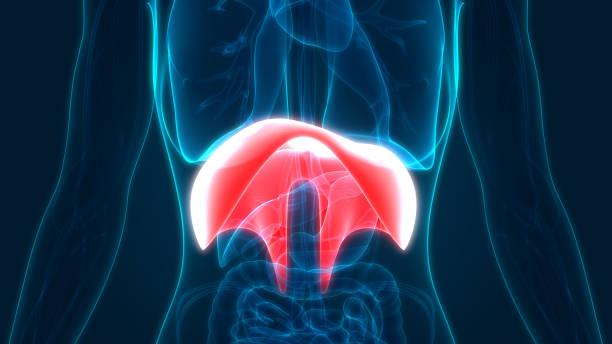Diaphragm is a thin muscular and tendinous septum that separates the chest cavity above from abdominal cavity below. It is pierced by the structure that passes between chest and abdomen. The shape and functions of diaphragm makes it the most important muscle of respiratory system.
Diaphragm has dome shape consisting of peripheral muscular part which arises from the margins of thoracic opening and centrally placed tendon.
Also read: Spinal health: The backbone is most valuable part of your body
Origin of diaphragm
The origin of diaphragm can be divided into three parts :
- Sternal part- arises from the posterior surface of xiphoid process.
- Costal part- arises from deep surface of lower six ribs and their costal cartilage.
- Vertebral part- arises by crura or the vertical columns and from the arcuate ligament.
- Right crus– arises from the sides of the bodies of first three lumber vertebrae and intervertebral disc.
- Left crus– arises from the sides of the bodies of the first two lumber vertebrae and intervertebral disc.
Let’s discuss the shape and functions od diaphragm.
Shape of diaphragm

The diaphragm seems to be curved up into right and left domes. The right dome reaches as high as upper border of fifth rib and left done may reach the lower border of fifth rib. The central tendon is present at the level of xiphisternal joint. The domes support the right and left lungs whereas the central tendon support the heart.
The level of diaphragm vary with phase of respiratory to the posture and the degree of distention of abdominal viscera.
Also read: Cardiovascular Diseases: Leading Cause of Deaths Globally
Functions of Diaphragm
The diaphragm has four main function :
- Muscle of inspiration- on contractions the diaphragm pulls its central tendon down and increases the vertical diameter of thorax. The diaphragm is most important muscle used in the inspiration.
- Muscle of abdominal straining- the contractions of diaphragm assist the contractions of muscle of anterolateral abdominal wall in raising the intra-abdominal pressure for micturition, defecation and parturition. Taking a deep breath and closing the glottis of larynx further aids this mechanism. The diaphragm is unable to rise because of the air trapped in respiratory tract now again air may allow to escape producing grunting sounds.
- Weight lifting muscle- in people taking a deep breath and holding it, the diaphragm assists the muscle of anterolateral abdominal wall increasing the intra-abdominal pressure to such an extent that it provides support to the vertebral column and avoid flexion. This greatly assists the post vertebral muscle in lifting of heavy weight. Needless to say, adequate sphincteric control of bladder and anal canal is important under these circumstances.
- Thoracoabdominal pump- the descent of the diaphragm decrease the intrathoracic pressure and at the same time increase the intra-abdominal pressure. This pressure change compresses the blood in inferior vena cava and forces it upward into right atrium of the heart. Lymph within the abdominal lymph vessels also compresses and the negative intrathoracic pressure aids it’s passage upward within thoracic duct. The pressure of valve within the thoracic duct prevent backflow.
Diaphragm openings
The diaphragm has three main opening :
- The aortic opening lies anterior to body of the 12 thoracic vertebrae and between the crura
- The esophageal opening lies at the level of 10th thoracic vertebrae in a sling of muscle fiber derived from the right crus
- The caval opening lies at the level of eighth thoracic vertebrae in central tendon
Nerve supply of diaphragm
Motor nerve supply: the right and left phrenic nerves (C3,4,5) .
Sensory nerve supply: the parietal pleura and peritoneum covering the central surfaces of diaphragm are form phrenic nerve and the periphery of diaphragm is from lower six intercostal nerves
On contractions the diaphragm pulls down it’s central tendon and increases the vertical diameter of thorax. Recognizing that the diaphragm flattens during contractions and elevates during relaxation is important.
Also read: Myths about the human body



















